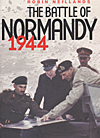 Cassell, 2002, $29.95, ISBN 0-304-35837-1, 456 pages, hardback
Cassell, 2002, $29.95, ISBN 0-304-35837-1, 456 pages, hardback
In this eminently readable account of the Battle of Normandy from 6 June to 1 September 1944, Neillands concentrates on the British and Canadian efforts. His aim is a reassessment of the battles to analyze which army did what well or poorly, in part to showcase the British and Commonwealth armies.
Most histories diminish such contributions, as well as criticize Montgomery for being overly cautious and slow. Neillands refutes this, drawing on original orders and examining not just miles moved and objectives taken, but opposition encountered.
The battles around Caen, a D-Day objective, are a case in point. Monty’s plan envisioned a solid left flank anchor (Brits and Canadians) and a sweeping right hook (US). The bocage (hedgerows) and Suisse Normande (rising hills and ridges) prevented such decisive US sweeps, while a half dozen top-notch SS and Panzer divisions stalled any British/Canadian breakouts. But the plan -- Monty’s plan -- for the Brits to lure in the German armor while the Americans broke through, worked. The strategic objective of reaching the Seine River and Paris at 90 days after D-Day was accomplished. Casualties were heavy, mistakes made, and opportunities missed, but on the whole, Monty’s plan worked.
In his analysis, Neillands switches between various official histories, numerical summaries, and personal observances of walking the battlefield. In addition, first person accounts pepper the narrative, lending a grunt’s-eye view to the grand operational plans. He has a knack with his prose of making the differences between plans and actual accomplishments understandable.
In counteracting pro-US arguments about who did more to win the Normandy Campaign, he does lean pro-British/Canadian. That’s not a negative, but an inevitable byproduct of examining British/Canadian contributions. He praises the German Army for their dogged and tactically intelligent defense of the rugged terrain, and touts Montgomery’s military prowess and organizational acumen.
All told, Battle of Normandy 1944 presents a well-written, sympathetic examination of British and Canadian efforts during the campaign. As most Americans are mostly unaware of such contributions, it’s an excellent place to start for info about the “other” Allies in Normandy. Whether it ends all the finger pointing remains to be seen, but it offers perspective and insight into one of the turning points of WWII.
Back to List of Book Reviews: World War II
Back to Master List of Book Reviews
Back to Master Magazine List
© Copyright 2003 by Coalition Web, Inc.
This article appears in MagWeb (Magazine Web) on the Internet World Wide Web.
Other articles from military history and related magazines are available at http://www.magweb.com